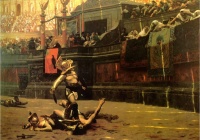Amphitheatre
From The Art and Popular Culture Encyclopedia
|
"Happily for the Colosseum, the shape necessary to an amphitheatre has given it a stability of construction sufficient to resist fires, and earthquakes, and lightning, and sieges."--Remarks on Antiquities, Arts, and Letters, during an Excursion in Italy in the years 1802 and 1803 (1813) by Joseph Forsyth |

|
Related e |
|
Featured: |
An amphitheatre (alternatively amphitheater) is an open-air venue for spectator sports, concerts, rallies, or theatrical performances. There are two similar, but distinct types of amphitheatres: Ancient amphitheatres, built by the ancient Romans, were large central performance spaces surrounded by ascending seating, and were commonly used for spectator sports; these compare more closely to modern open-air stadia. Modern amphitheatres, are more typically used for theatrical or concert performances and typically feature a more theatrical-style stage with audience only on one side, usually at a radius of less than a semi-circle; these compare more closely to the theatres of ancient Greece, and have been more commonly built throughout history as performance spaces. Amphitheatres are typically man-made, though there are also geological formations used in the same manner which are known as natural amphitheatres.
The term derives from the ancient Greek amphi-, meaning "around", or "on both sides" and théātron, meaning "place for viewing".
See also

